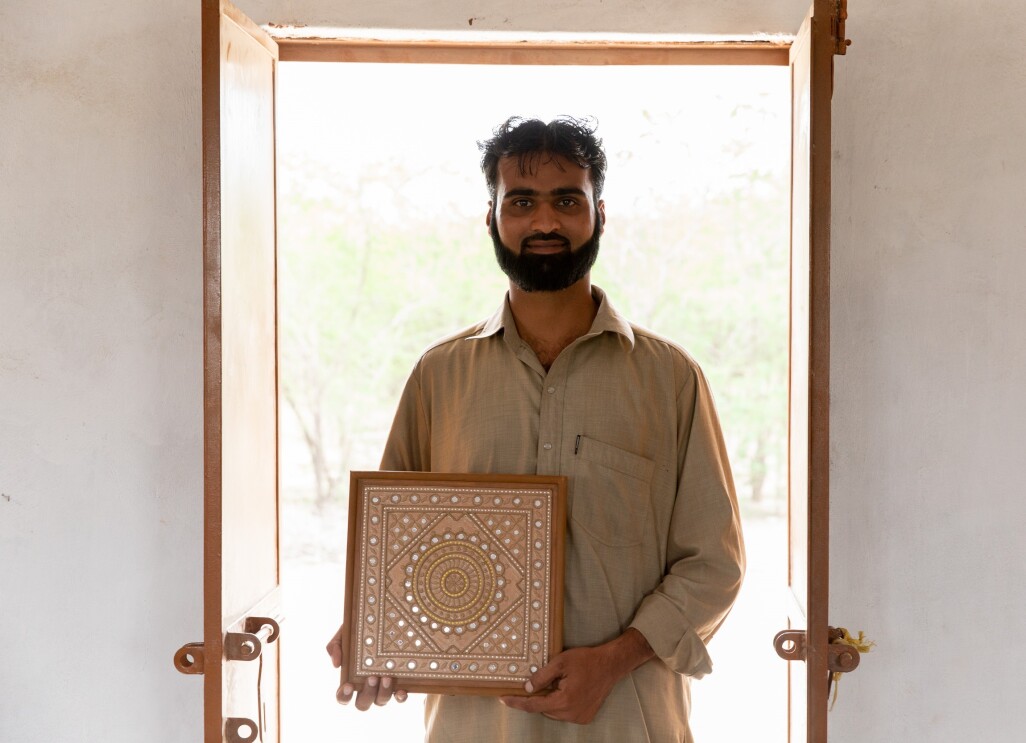
Siniyado - the place where 29-year-old Majikhan Ilamkhan Mutva, is reviving the forgotten art of moulding mud into creative art pieces - is bang in the middle of grasslands or “banni” as the locals call it. His one room workshop, painted in white with a red border, stands out amongst the trees. Soon we hear his bike and he stops at the entrance of the workshop saying, “You know we are just a few kilometres away from the White Rann? It has shot to fame after the Rannostav…but we have been natives of this place for years. Just 40 or so families stay here.” As some little kids from his family and those of his neighbours' run around the place, he says, “All of us have grown up in this banni, so though you may find it all tucked away from the hustle-bustle, but we are used the quiet atmosphere and enjoy it.”
As we get ready to get up close with the art, Maji tells the kids to run back home and takes us to his workshop. He first removes a plastic cover and keeps the moulded mud on a table, covers it and shows us a few samples of the art that are ready to be packed. He says, “There are a few families in my village – basically from the Mutwa community- who have been doing this art work for years and I have been observing them since I was young. I too am from the Mutwa community and this is something I felt I could take up as full time work and here I am doing this since 2013!”

You can’t but help wonder at the enthusiasm of the man; because to create this art from a remote village can get exhausting. And not only does Maji Khan create this art, he also markets it himself. He tells us, “I make this art form here in Siniyado, but I have to travel to Bhuj for the raw material – the mud is golden brown in Bhuj, which is perfect for my art and the plywood which forms the base, I get from there. I spend an entire day and sometimes more depending on how much raw material I have to bring back home. I often use different modes of transport to reach Siniyado, so this can get tiring, but it is the only way I know.”

However, the rustic demeanor of Maji Khan hides the fact that he is extremely tech savvy and knows that in this digital age, anything is possible. “I have my YouTube channel, Facebook and Insta account – where I showcase my work and get queries and orders. I then supply accordingly. However, after going online on Amazon, there has been a steady growth in orders. The name Amazon means a lot and customers feel that if you are on Amazon – you will supply goods of a certain quality and I have not disappointed them thus far.”
Maji Khan has orders to fulfill and goes about working on an art work that he has to complete. As he kneads the mud and tells us of the process (see the video), he starts making fine lines with the mud on the board. They all come together in a beautiful design and he embellishes them with sequins and mirrors. “Many paint this also, but I believe in keeping it real – in the colour of the mud,” says Maji Khan as he keeps the same to dry and adds, “from 3-4 hours for a 12 inch by 12 inch frame to days, how long one frame takes depends on the size and the complexity of the design. Currently, I am the only one in my village doing this, but just like I learnt, there are people in my village who are eager to learn. I am the only one in my village to use technology to sell an art form and comfortably from remote Siniyado. So one thing my village folk know is that if you do this art with conviction and hard work, there is money in this art, is art mein profit hai!”











